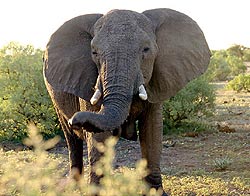Elephant Information
 |
Quick Elephant Facts
Family: Elephantidae (Elephants)
Scientific name: Loxodonta africana
Average shoulder height: Males - 3.5 m;
Females - 2.7 m
Weight: Males - up to 6 tons; Females - 2.7
tons
Gestation period: 22 months
Life expectancy: 60 yrs
|
Trunk
The elephant's nose and upper lip are elongated into a
muscular, powerful trunk. This truly multi-purpose tool
is powerful enough to uproot trees but dextrous enough
that the two 'fingers' at its tip can pick up single
seeds. Elephants can swim considerable distances and, in
deeper water, will use their trunks like snorkels.
Tusks
The tusks are elongated upper incisor teeth and are not
necessarily the same size. Some adults lack tusks and
some have only one. Bulls typically have thicker, heavier
tusks than females. Elephants will often uproot trees and
then use their tusks to chisel the bark off.
Eyes and Ears
An elephant's eyes are small
relative to the huge size of the animal. The ears are
very large, flat and roughly the shape of the African
continent, often with tears and holes in them. The ears
are laden with blood vessels and when flapped, help bring
down the huge beast's body temperature.
Feet and Tail
The
front feet are roughly circular, with five blunt
toenails; the hind feet are oval, with four blunt
toenails. The soles are padded, allowing amazingly silent
movement for such a large amimal. The tail is thin, up to
1.5 m long, and has a whisk of long, thick hairs at the
end.
Visible Male/Female Differences
Females have one
pair of mammae, low on the sides of the chest, just
behind the forelegs. Both sexes have a thick flap of skin
hanging between their hind legs. Males are larger, taller
and twice as heavy as cows. Bulls have wider heads and in profile they have a more
rounded forehead.
Diet
Very unselective; when browsing acacias they swallow
more wood than leaves. In summer, grass forms the bulk of
the diet, replaced in winter by woody plants. Intake is
about 150 kg wet weight per day while water intake is 120
litres a day for an adult bull.
Reproduction
Single calves weighing 120kg are born throughout the year after a gestation of 22 months.
Calves are weaned at 3-8 years, just before the birth of the next calf.
Sounds
Elephants are very vocal, producing a wide variety of squeals, screams and high-pitched
trumpeting which are audible to humans. Seventy-five percent of the vocal communication
uses frequencies too low for humans to hear.
If you'd like to find out more about how elephants communicate, you should read this in-depth yet fascinating
academic paper, Social Behaviour and Communication in Elephants.
For additional information on elephants, see also African Elephant Biofile.
Return to Wildlife Info.
|

